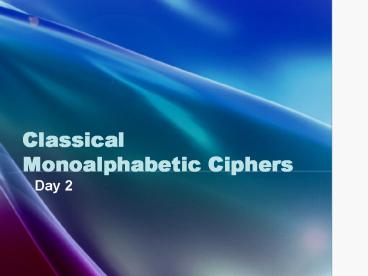Classical Monoalphabetic Ciphers - PowerPoint PPT Presentation
1 / 15
Title:
Classical Monoalphabetic Ciphers
Description:
Write the keyword below the alphabet and fill in the rest of the ... Monoalphabetic and some substitutions for words or phrases. Mary, Queen of Scots. Review ... – PowerPoint PPT presentation
Number of Views:1266
Avg rating:3.0/5.0
Title: Classical Monoalphabetic Ciphers
1
Classical Monoalphabetic Ciphers
- Day 2
2
Keyword cipher
- Select a keyword, if the keyword has any repeated
letters, drop all but the first occurrence. - Write the keyword below the alphabet and fill in
the rest of the space with the remaining letters
of the alphabet in their standard order. - VBA Code
- Modification Allow the keyword to start anywhere
along the alphabet.
3
Keyword cryptanalysis
- Dictionary attach using a computer.
- Every letter of a language has a personality of
its own. - Determine the personality of each character in
the ciphertext and try to match them with the
known personalities of corresponding plain text. - This attach was used as early as the 9th century,
by Arab scientist and philosopher al-Kindi.
4
Frequency analysis
- Assignment
- Download Frequency_Analysis.xls from the SMA
website. - Find a 200-500 word section of common English
writing. Copy and format it in Word. - Copy it.
- Use it in the Excel spreadsheet to do a single,
double, and triple letter frequency count.
5
Compile class data
6
Frequency analysis
- r forms digrams with more different letters
more often than any other letter. - The three vowles, a, I, and o avoid each
other, except for io. - ea is the most frequent digram involving
vowels. - Eight percent of the letters that procede n are
vowels. - h frequently appears before e and almost
never after it.
7
Frequency analysis
- Be willing to give up on an assumption and try
something else if it appears that you are on the
wrong path.
8
Affine cipher
- Each letter is assigned a number. a 0, b
1, c 2, - The key to an affine cipher is a pair of numbers
(a, b). - The greatest common divisor (GCD) of a and 26
must be 1. - Let p be the number of the plaintext letter and c
the number of the ciphertext letter. - c (a p b) mod 26
- p (a-1(c b)) mod 26
9
Affine example
Note a a-1 1 (mod n)
- a 3, b 7
- Find the equations for encryption and decryption.
- Encrypt the message the dog
- Decrypt the message TIVUJWL
10
Affine cryptanalysis
- Is an affine cipher easier or harder to break
then a keyword cipher? - How would we break an affine cipher?
11
Multiliteral cipher
- It replaces each plaintext letter with a pair of
letters. - Choose a 5 letter keyword with no repeating
letters. - i and j occupy the same cell.
12
Multiliteral cryptanalysis
- Is an multiliteral cipher easier or harder to
break then a keyword cipher? - How would we break an multiliteral cipher?
13
Monoalphabetic cipher history
- The Argentis worked for the Pope during the late
1500 and early 1600s. - Probably first to use keyword
- Numbers were used instead of letters
- Used by the South during the Civil War.
14
Monoalphabetic cipher history
- Middle Ages nomenclator
- Monoalphabetic and some substitutions for words
or phrases - Mary, Queen of Scots
15
Review































